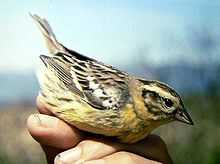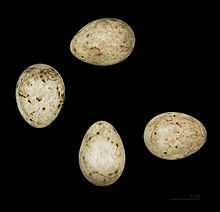Yellow-breasted bunting
| Yellow-breasted bunting | |
|---|---|
 | |
| Adult female | |
| Conservation status | |
| Scientific classification | |
| Kingdom: | Animalia |
| Phylum: | Chordata |
| Class: | Aves |
| Order: | Passeriformes |
| Family: | Emberizidae |
| Genus: | Emberiza |
| Species: | E. aureola |
| Binomial name | |
| Emberiza aureola Pallas, 1773 | |

The yellow-breasted bunting (Emberiza aureola) is an Eurasian passerine bird in the bunting family (Emberizidae).
This bird is similar in size to a reed bunting, but longer-billed. The breeding male has bright yellow underparts with black flank streaks, brown upperparts, black face and throat bar, and a pink lower mandible.
The female has a heavily streaked grey-brown back, and less intensely yellow underparts. She has a whitish face with dark crown, eye and cheek stripes. The juvenile is similar, but the background colour of the underparts and face is buff.
The call is a distinctive zick, and the song is a clear tru-tru, tri-tri.
It breeds in north-eastern Europe and across northern Asia. It is migratory, wintering in south-east Asia, India, and southern China. It is a rare but regular wanderer to western Europe.
The yellow-breasted bunting breeds in open scrubby areas, often near water, and is present in Siberia. It lays for to six eggs in a nest on the ground. Its food consists of insects when feeding young, and otherwise seeds.
Until 2004, the International Union for the Conservation of Nature considered the yellow-breasted bunting to be a species of least concern. In 2004, its status was changed to near threatened, and four years later it was uplisted again — to vulnerable — after new research has shown it to be rarer than had been believed. In 2013, its assessment changed to endangered.[2]
Footnotes
- ↑ BirdLife International (2013). "Emberiza aureola". IUCN Red List of Threatened Species. Version 2013.2. International Union for Conservation of Nature. Retrieved 26 November 2013.
- ↑ "Yellow-breasted Bunting Emberiza aureola". BirdLife International. Retrieved 11 December 2014.
External links
- OBC 24 photographs (see pulldown menu at page bottom)
